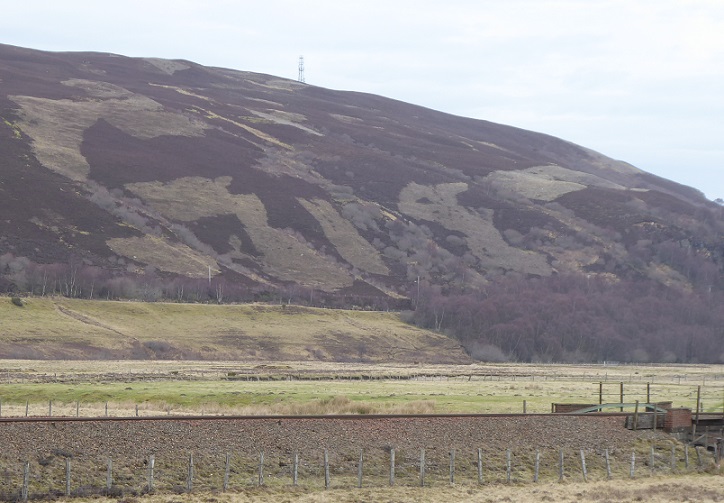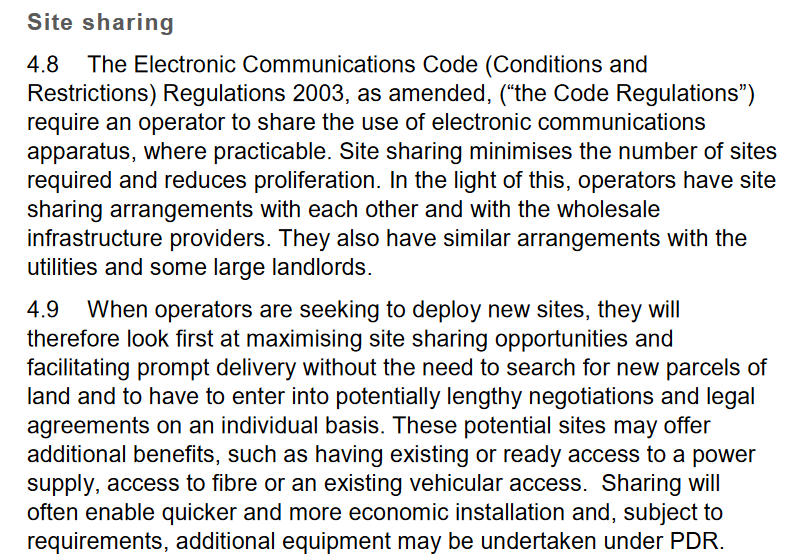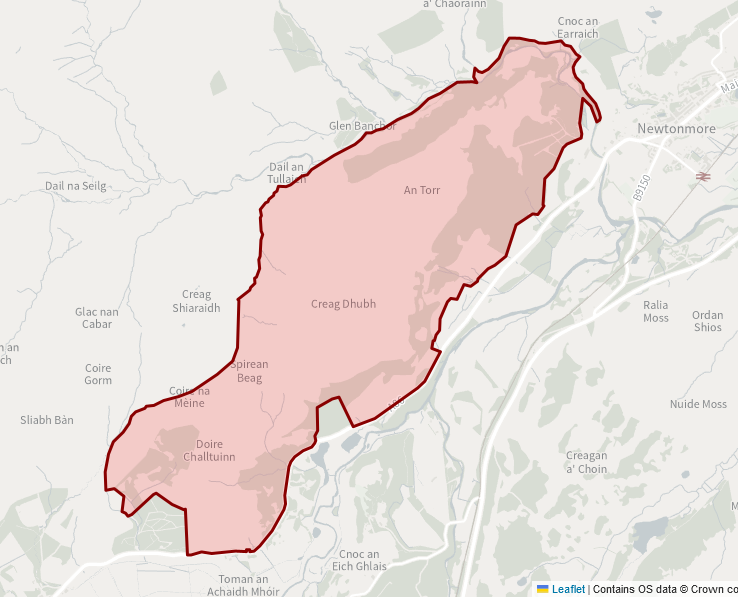
On 20th October Highland Council validated a planning application (see here or ref 23/04700/FUL) to erect a 25m high telecommunications mast high on Creag Dubh between Newtonmore and Laggan. Since Creag Dubh is protected as a Site of Scientific Interest the mast requires full planning permission and Highland Council has the power to reject it.
As per agreed procedures on 2nd November Highland Council notified the Cairngorms National Park Authority (CNPA) of the application. On 13th November the CNPA decided the “planning application does not raise any planning issues of general significance to the park aims and as such No Call-in is necessary in this case”. What that means is that the CNPA has decided there is no reason to object to the mast and they are happy to leave the decision to Highland Council. (The CNPA’s letter is available on their planning portal but for some unknown reason has yet to be published on the Highland Council planning portal).
No need for a mast on Creag Dubh

Anyone who has travelled along the A9 corridor will know that the landscape in Speyside is already littered with telecommunications masts. Laggan Community Council, in an excellent objection to the application lodged in December, explained that a new mast is not needed:
“The proposed installation is to allow Virgin/O2 to provide a service in a partial not-spot area.
However excellent 4G reception throughout the area is already provided by an EE mast 4.5km away at Catlodge (Grid ref: NN6315 9307). The Shared Rural Network (SRN) initiative requires operators to share masts in partial not -spot areas wherever possible, avoiding duplication of infrastructure & minimising the impact on our local area. There is no evidence in the application that this has been considered.
While the Scottish Government’s planning guidance on Digital Communications issued just before Xmas pays little regard to landscape or wild land (see here), it is very clear and helpful in one respect. Masts should be shared by mobile phone operators wherever possible:

So why won’t O2 and Virgin share EE’s mast? Are EE wanting to charge them so much that it is cheaper to build a new mast? Highland Council make it its business to find out.
This is the crucial point, there appears to be no justification for this mast and it raises serious questions about the need for many of the other planning applications for masts currently in the pipeline for “Partial Not Spots” across Scotland.
NatureScot and the CNPA’s responses to the application
Had either NatureScot or the CNPA objected to the proposed mast on Creag Dubh on the grounds that it was not needed, then I think the developer would have been forced to withdraw it – whatever the issues it raises in respect of the landscape and natural environment. Instead, despite this application being a sitting duck, both have run a mile and in doing so abdicated their responsibilities.
NatureScot in their response start by explaining that they are not going to comment on the landscape impact of the proposed mast because they have an agreement with the CNPA that the latter will lead on landscape issues in the National Park. They go on to say:

This statement serves to undermine the entire system of Sites of Special Scientific Interest in Scotland. The Creag Dubh SSSI covers a significant area very little of which – as you can see from the photo above – is covered by birch woodland:

There is a reason for this: the SSSI continues to be overgrazed by deer and goats and when last assessed way back in 2009 (according to the Site Link website) was in unfavourable condition. Had the number of deer and goats, however, been controlled as they have been across the Spey by the landowners involved in Cairngorms Connect – which include NatureScot – much of the area by the proposed mast might have been covered by birch woodland.
Why designate an area around a “qualifying feature” in the case of woodland if the intention was not to enable it to expand? If NatureScot is not prepared to protect areas such as this which are included in designated sites, it should stop pretending and try to de-designate those sites. There would be public uproar of course and so there should be about NatureScot’s failure to fulfil its statutory responsibilities in the case.
Responsibility for this failure does not lie with front-line staff. Most know that adopting positions like this is indefensible. The problem lies with senior management who are too closely linked with central government and have instructed staff not to get in the way of development. That has gone so far that staff are not even allowed to object to developments that are completely unwarranted.
The position of the CNPA is equally indefensible. Creag Dubh is in the Ben Alder, Laggan and Glen Banchor Special Landscape Area. The CNPA has a statutory duty to protect the landscape in the Cairngorms but despite the proposed mast being in an area where the importance of the landscape is recognised believes the application does not raise “any planning issues of significance to the national park’s aims”. Really? In taking this position they have undermined landscape protection just as much as NatureScot have undermined nature protection.
What needs to happen
It should be clear from the evidence of what has happened up until now (see previous posts) that the Scottish Government and its agencies to take a more strategic approach in respect of the £1bn Shared Rural Network programme. More specifically they should not leave it to the mobile phone operators to take the initial decisions about where new masts should be located.
Setting aside its mistaken backing for new telecommunications masts in as many “total not spots” as possible, the Scottish Government could stop the proliferation of mast applications in “partial not spots”. All it needs to do is call in the mobile phone operators and tell them that they must share masts, as per its latest guidance. This would help protect places like Creag Dubh and the many important landscapes in Scotland around where people live. It would also save planning authorities, local communities and landscape campaigners wasting a lot of time and effort..
Meantime, both our National Park Authorities could show a lead and adopt a more detailed policy position to deal with respect to the large numbers of mast applications that are being submitted under the Shared Rural Network programme. Such a policy should start from a presumption against new masts unless they benefit local communities. That would prevent new masts, like that proposed for Creag Dubh, in partial not spots and help protect wild land.
One thing the CNPA and the Scottish Government could do to help with this this is by mapping Scotland to show the sites of existing masts, partial not spots and total not spots. That information could then be mapped against wild land and National Scenic Areas (as per the examples in Robert Craig’s post (see here)). Such mapping would help identify the areas where new masts are most needed by local communities.
The need for new masts should also take account of rapidly advancing developments which will make satellite technology widely available. This means many masts could be redundant in a few years time. The focus therefore should be on constructing new masts to cover settlement “not spots” not places like Laggan. The expectation should then be that Wild Land and similar areas should be covered by satellite technology. This is already available, for a price, to those working in these areas (like estate staff and mountain rescue teams) and undermines the argument of the Scottish Government that we need masts to cover all total not spots.
This is among the worst of the new telecommunications masts proposed for Scotland. The view west and south from Creag Dubh is one of the finest in the national park, extending all the way to Ben Nevis. The proposed mast would be a massive intrusion into this landscape and would significantly degrade the quality of public enjoyment of the main route of ascent of Creag Dubh, impacting on local people and visitors to an unacceptable extent. The failure of Nature Scot and the Cairngorms National Park Authority to object to this planning application, in the strongest terms, is a dereliction of duty. It calls into question the competence of these public bodies in their role as guardians of our environment. But the planning application has not yet been determined by Highland Council so the opportunity for public objections remains. These should be submitted as soon as possible to the Council – see the planning portal reference 23/04700/FUL. The objection from Laggan Community Council is in the documents section and perfectly summarises the reasons why this application should be rejected on the grounds of its environmental impact and the availability of an alternative existing mast location at Crubenmore.
Thanks for the heads up. Objection submitted.
The whole concept of different Telecoms companies sharing masts is ludicrous. Why can’t we use the mast with the best signal independent of its owner? If you go to Europe your phone picks up whichever company is offering the best signal and your mobile phone provider then presumably gets cross charged. They then bill you if necessary. The technology clearly exists. So why isn’t it also used in the UK?
The CNPA is a development agency not a curator of a previous landscape so I wouldn’t have expected any better. There’s no obvious deficit in the phone signal around here. My family is at Laggan and we have perfectly adequate phone and broadband (we can stream TV).
No problem with signal this is an unnecessary blight on this beautiful landscape – are you trying to wreck it!! Totally against!
Considering the historic and cultural significance of Creag Dubh (especially to the Clan Macpherson) and its current use as one of the more popular local walking and running hills its clear that this decision has been made from a ten thousand foot view and not with the slightest interest in the opinion of the very people it is supposed to serve. As stated above this is not an issue of network coverage but one of corporate competition and as such has no public benefit, only public cost to support corporate profit.